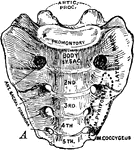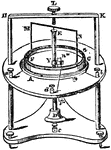
Electric Apparatus
"ABC is a horizontal coil of wire terminating at the binding screws a, b. FG is a ring-shaped trough…
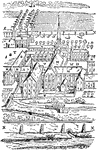
Bird Eye View of Citeaux
A. Cross, B. Gate-house, C. Almonry, D. Chapel, E. Inner gate-house, F. Stable, G. Dormitory of lay…

Noctiluca Miliaris
"Flagellum of Noctiluca miliaris (highly magnified). s, transversely striated substance; b, base of…
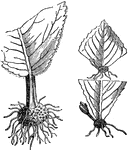
Leaf Cuttings
"Many plans may be propagated by planting their leaves or portions of their leaves as cuttings, as,…
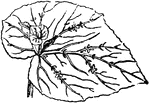
Leaf Cuttings
"Many plans may be propagated by planting their leaves or portions of their leaves as cuttings, as,…

Pyramid Pruning
"a shows a young tree with its second year's growth, the upright shoot of the maiden tree having been…
Pruning
"The nature of the cut itself in pruning is of more consequence, especially in the case of fruit trees,…

Pruning
"The nature of the cut itself in pruning is of more consequence, especially in the case of fruit trees,…
Pruning
"The nature of the cut itself in pruning is of more consequence, especially in the case of fruit trees,…
Pruning
"The nature of the cut itself in pruning is of more consequence, especially in the case of fruit trees,…
Pruning
"The nature of the cut itself in pruning is of more consequence, especially in the case of fruit trees,…
Pruning
"The nature of the cut itself in pruning is of more consequence, especially in the case of fruit trees,…

Muscular Cells
"Muscular cells of medusae (Lizzia). The uppermost is a purely muscular cell from the sub-umbrella;…

Lizzia
"Medusiform person (Lizzia), one of the Anthomedusae, detached from a hydroid colony of the family Endendridae.…
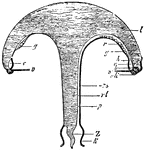
Anthomedusae
"Medusiform person, one of the Anthomedusae, detached from a hydroid colony of Syncoryne. Ocelli are…
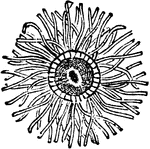
Actinia
"A genus of marine animals closely allied to the Hydraform Polypi, but of much greater size, and always…
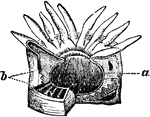
Actinia
"A genus of marine animals closely allied to the Hydraform Polypi, but of much greater size, and always…

Arum Maculatum
"Arum maculatum. a, leaves and root; b, spathe, with base of spadix exposed; c, fruit." — Chambers'…

Dittany
"A genus of plants of the natural order Rutaceae, having a short 5-partite calx, five some-what unequal…

Schizomus
"Schizomus crassicaudaius, one of the Tartarid Pedipalpi. Ventral view of a female with the appendages…

Liphistius Desultor
"Liphistius desultor. Lateral view. I to VI, Appendages of the prosoma cut off at the base. o, Ocular…

Koenenia Mirabilis
"Koenenia Mirabilis, Grassi, one of the Palpigradi. A, Ventral view of prosoma and of anterior region…

Galeodes
"Galeodes sp., one of the Solifugae. Ventral view with the appendages cut off at the base. I to VI,…
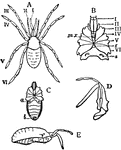
Stylocellus Sumatranus
"Stylocellus sumatranus, one of the Opiliones; after Thorell. Enlarged. A, Dorsal view; I to VI, the…

Arch
"The blocks, which are technically known as voussoirs, should be of a wedge shape, the center or top…
Bicycle Chain
"The "block" chain consists of a series of central blocks connected by side plates." — The Encyclopedia…

Furnace
"The section and ground plan of one of the older forms of open-mouthed furnaces used at Dowlais (Truran),…

Furnace
"The more modern furnaces are constructed like this, but the masonry at the base is still less massive,…
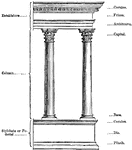
Elements of an Architectural Order
A diagram showing the titles for different types of architecture.

Electrical Machine
"The electrical machine most usually employed consists of a large circular plate of glass, mounted upon…
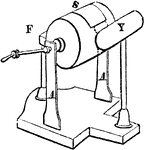
Electrical Machine
"A form of an electrical machine. S being the glass cylinder turning on an axis, Y the conductor, F…

Lapidary's Mill
"Part of Lapidary's Mill. A, upper summer (cut through); B, lower summer (cut through); C, spindle;…
Beacon
"Beacons in exposed situations are constructed sometimes of stone, and cement-concrete or cement-rubble,…
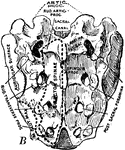
Human Sacrum
A large triangular bone as the base of the spine. Resides in between the two hip bones.

Mouth
"The mouth, nose and pharynx, with the commencement of the gullet and larynx, as exposed by a section,…
Hair
A hair. 1: External part; 2: Sac in skin; 3: Surface of Cuticle; 4: Sebaceous membrane; 5: Bulb at base;…

Primitive Crystal
"If the base is a square and the prism stands erect—that is, if its sides or lateral planes, as…
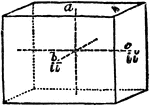
Primitive Crystal
"When the base is a rectangle instead of a square, the form is a right rectangular prism." —The…
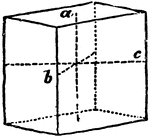
Primitive Crystal
"When the base is a rhombus, and the prism stands erect, the form is a right rhombic prism." —The…
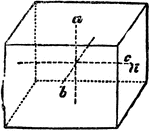
Primitive Crystal
"When the base is a rhomboid, and the prism stands erect, it is only the opposite laeral faces that…
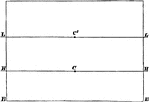
Horizontal Line Diagram
In this figure BB is the base line; HH the common horizontal or vanishing line; C…
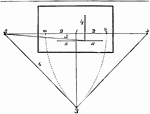
Angular Perspective
This figure comprises the whole of the points and lines preparatory to beginning a drawing in "angular…

Angular Perspective
The perspective in this plate is "angular perspective," and the figure it represents is a flat square…
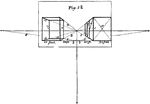
Parallel Perspective
Two upright oblong figures are here represented in parallel perspective. They may be imagined to resemble…

Vertical Line
That an accurate notion of the vertical line may be obtained, the plane of the picture must be supposed…

Geniculate Antenna
As a rule, the antennae are straight, without break from base to tip; but occasionally they are geniculate,…

Potato-Stalk Borer Larva
The potato-stalk borer, is a small ash gray weevil about one-sixth of an inch in length, with a black…

Potato-Stalk Borer Pupa
The potato-stalk borer, is a small ash gray weevil about one-sixth of an inch in length, with a black…

Potato-Stalk Borer Adult
The potato-stalk borer, is a small ash gray weevil about one-sixth of an inch in length, with a black…

Brachiopoda
Diagrammatic section through an arm of the lophophore of Crania. 1, the lip; 2, the base of a tentacle…
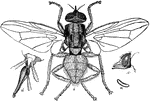
Horn Fly
This insect derives its common name from the fact that it seems to prefer clustering in great numbers…

Bryophyta
Funaria hygrometrica. Median longitudinal section of a capsule, with the seta gradually widening into…

Flax-seed
Section of a flax-seed magnified and divided flat-wise: turned round, so that the stem-end (caulicle)…

Germination of Silver Maple
Germination of Silver Maple, natural size; merely the base of the fruit, containing the seed, is shown.
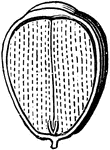
Acorn
Half of an acorn, cut lengthwise, filled by the very thick cotyledons, the base of which encloses the…

Auxiliary Bud
An auxiliary bud, concealed under the hollowed base of the leafstalk, in Buttonwood or Plane-tree.
Red-Maple branch
Red-Maple branch, with accessory buds placed side by side. The annular lines toward the base are scars…
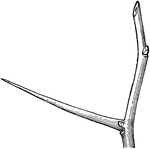
Cockspur Thorn
Spine of Cockspur Thorn developed from an auxiliary bud, as the leaf-scar below witnesses: an accessory…
